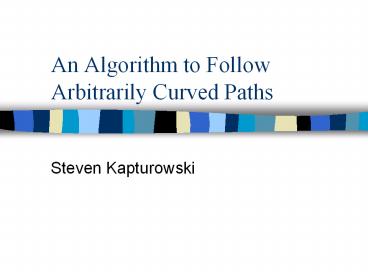An Algorithm to Follow Arbitrarily Curved Paths - PowerPoint PPT Presentation
Title:
An Algorithm to Follow Arbitrarily Curved Paths
Description:
... spline models Little work found on velocity control and curvature measurements Approach Paradigm Task-oriented 3D and motion ... Graphics 17(3) ... equation for ... – PowerPoint PPT presentation
Number of Views:48
Avg rating:3.0/5.0
Title: An Algorithm to Follow Arbitrarily Curved Paths
1
An Algorithm to Follow Arbitrarily Curved Paths
- Steven Kapturowski
2
The Problem
- Given a curved path, find the appropriate
movement so as to advance along the paths center - Must be able to moderate ones speed along path
so as to minimize acceleration endured by the
body - Should be robust to noise and missing data
3
Solution Concept
- We assume image has been preprocessed to find
image points of road edges - Find a best fit curve for each road side
- Use slope of curves to estimate vanishing point
- Correlate radius of curvature to maximum safe
velocity
4
(No Transcript)
5
Curve Fitting
- Use cubic spline curve to model road edge data
- Reduces noise compared to working with raw data
- Allows data interpolation when edge regions are
missing
6
Curve Fitting
- c(?) v1(1 ?)3 v2 ? (1 ?)2 v3 ? 2(1 ?)
v4 ? 3 - Minimize objective function
- E(v1, v2, v3, v4) ?i c(?min,I) - pi2
- Currently using mean squared error (may change to
weighted mean squared error as appropriate) - For fixed v, c(?) - pi one can find ?min,I by
numerically solving D? c(?min,I ) - pi 0
(Quintic Polynomial) - Nonlinear optimization problem
7
Why look at curvature?
- ? ?3 / ?2?2 - (??)21/2
?
aTransverse v2 / ?
Need aTransverse lt amax
?
a aTransverse2 aparallel2
8
Curvature Continued
- Should be able to assume ground is level with
optical axis for small z - This allows us to find world curvature near the
camera - Not completely clear what to make of image
curvature when z is not small
Image Plane
focus
z
h
df
9
Literature Survey
- Significant work done on edge detection Ref. R
focuses on straight roads but detects boundaries
in highly non-ideal conditions - Several papers explore curve fitting to determine
vanishing points - Ref. MDMT explores a road model consisting of
concentric circular arcs - Ref. WTS Considers formation of cubic and
quartic spline models - Little work found on velocity control and
curvature measurements
10
Approach Paradigm
- Task-oriented
- 3D and motion based vision
- Recovery only of select details
11
Completed Work
- Developed road simulation model
- Data structures to facilitate algorithms
- 75 finished with curve fitting routine
12
Goals (certain to complete)
- Program vanishing point detection
- Continue investigating relationship between image
curvature and world curvature - Test algorithms with incomplete and noisy data
13
Goals (if time permits)
- Relax idealized parameters
- Test on real world data
- Add lane constraints
- Compare results with different road models
- Explore hybrid road models
14
References
- WTS Wang, Y., Teoh, E.K., Shen, D.Lane
detection and tracking using B-Snake Image and
Vision Computing 22 (2004) - MDMT Morgan, A.D., Dagless, E.L., Milford,
D.J., Thomas, B.T. Road Edge Tracking for Robot
Road Following Image and Vision Computing 8(3)
(1990) - PS Plass, M., Stone, M. Curve-fitting with
Piecewise Parametric Cubics Computer Graphics
17(3) (1983) - R Rasmussen, C. Grouping Dominant Orientations
for Ill-Structured Road Following Computer
Vision and Pattern Recognition, Proceedings of
the 2004 IEEE Computer Society Conference on
15
Curvature Continued
- Possible Approach
- Knowing curvature near camera gives maximum speed
- Cant change speed instantaneously
- aTotal (v2 / ?)2 (?v/?t)21/2, where v
(v1v2)/2, ?v v2 - v1 - Quartic equation for v2 (has exact solution,
though even this could be much simplified under
certain assumptions) - Correspond high curvature points between images
- Find time to collision with image plane































